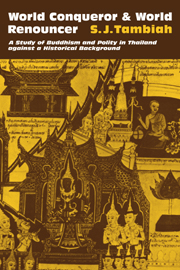Crossref Citations
This Book has been
cited by the following publications. This list is generated based on data provided by Crossref.
Tambiah, Stanley J.
1977.
THE GALACTIC POLITY: THE STRUCTURE OF TRADITIONAL KINGDOMS IN SOUTHEAST ASIA*.
Annals of the New York Academy of Sciences,
Vol. 293,
Issue. 1,
p.
69.
Johnson, George W.
1977.
1976 Annual Supplement.
p.
1.
Turton, Andrew
1978.
The current situation in the Thai countryside.
Journal of Contemporary Asia,
Vol. 8,
Issue. 1,
p.
104.
Lieberman, Victor B.
1978.
Ethnic Politics in Eighteenth-Century Burma.
Modern Asian Studies,
Vol. 12,
Issue. 3,
p.
455.
PAUL, ROBERT A.
1979.
Dumje: paradox and resolution in Sherpa ritual symbolism.
American Ethnologist,
Vol. 6,
Issue. 2,
p.
274.
Thapar, Romila
1981.
The householder and the renouncer in the Brahmanical and Buddhist traditions.
Contributions to Indian Sociology,
Vol. 15,
Issue. 1-2,
p.
273.
Scupin, Raymond
1981.
The socio‐economic status of Muslims in central and North Thailand.
Institute of Muslim Minority Affairs. Journal,
Vol. 3,
Issue. 2,
p.
162.
O'CONNOR, RICHARD A.
1981.
law as indigenous social theory: a Siamese Thai case.
American Ethnologist,
Vol. 8,
Issue. 2,
p.
223.
Marks, Thomas A.
1981.
Government policy as a reflection of the development model: The case of accelerated rural development (ARD) in Northeast Thailand.
Journal of East and West Studies,
Vol. 10,
Issue. 1,
p.
59.
1981.
INTRODUCING THE PSYCHOLOGY OF THE SELF AND NARCISSISM INTO THE STUDY OF RELIGION.
Religious Studies Review,
Vol. 7,
Issue. 3,
p.
193.
Tambiah, S.J.
1981.
The renouncer: his individuality and his community.
Contributions to Indian Sociology,
Vol. 15,
Issue. 1-2,
p.
299.
O'Connor, Richard A.
1982.
Everyday Life in Thailand: An Interpretation. By Niels Mulder. Bangkok: Editions Duang Kamol, 1979. Pp. vii, 223. Acknowledgements, Appendix, Bibliography, Index. Paperback..
Journal of Southeast Asian Studies,
Vol. 13,
Issue. 2,
p.
391.
Eisenstadt, S. N.
1982.
Entstehung und Strukturwandel des Staates.
p.
36.
Lansing, J. Stephen
1983.
The “Indianization” of Bali.
Journal of Southeast Asian Studies,
Vol. 14,
Issue. 2,
p.
409.
Sahlins, Marshall
1983.
Other Times, Other Customs: The Anthropology of History.
American Anthropologist,
Vol. 85,
Issue. 3,
p.
517.
ERRINGTON, J. JOSEPH
1984.
self and self‐conduct among the Javanese priyayi elite.
American Ethnologist,
Vol. 11,
Issue. 2,
p.
275.
Roberts, Michael
1984.
'Caste feudalism' in Sri Lanka? A critique through the Asokan Persona and European contrasts.
Contributions to Indian Sociology,
Vol. 18,
Issue. 2,
p.
189.
Hughes, Philip J.
1984.
The assimilation of christianity in the thai culture.
Religion,
Vol. 14,
Issue. 4,
p.
313.
Hanks, Lucien M.
1984.
Symposium on Societal Organization in Mainland Southeast Asia Prior to the Eighteenth Century: Foreword.
Journal of Southeast Asian Studies,
Vol. 15,
Issue. 2,
p.
219.
Winslow, Deborah
1984.
A Political Geography of Deities: Space and the Pantheon in Sinhalese Buddhism.
The Journal of Asian Studies,
Vol. 43,
Issue. 2,
p.
273.



